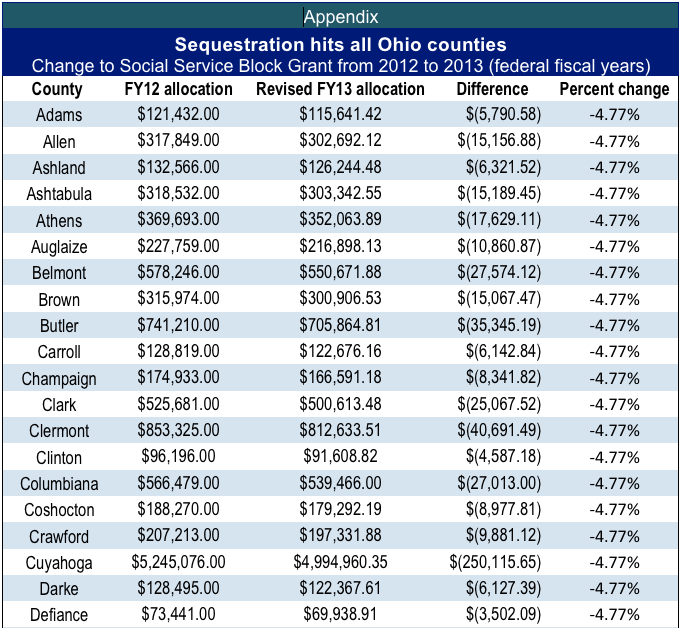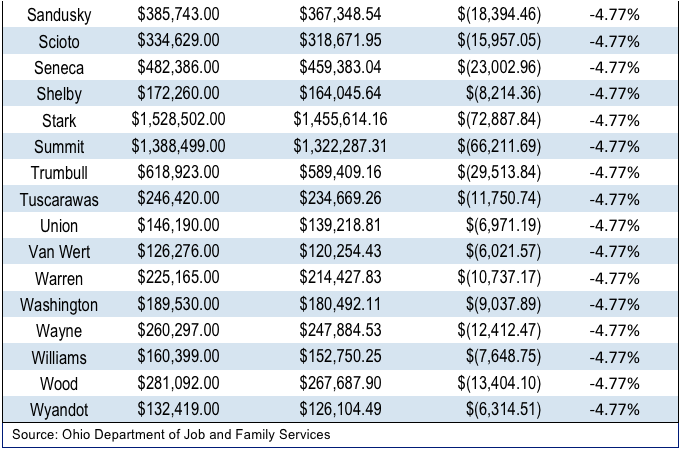
Federal Sequester Keeps Hitting Ohio
June 18, 2013
Federal Sequester Keeps Hitting Ohio
June 18, 2013
Note: An earlier version of this study incorrectly reported the amount Ohio will lose as a result of the sequester;it is $184 million for federal fiscal year 2013, which ends in September. Download summary (1 pg)Download report (7 pp)Press releaseAcross-the-board federal cuts will take $184 million out of Ohio’s budget in 2013. These cuts mean furloughed defense workers, cuts to county funds for social services, reductions to public health programs for teens and seniors alike, and ongoing loss of Head Start slots for preschoolers.
Automatic federal cuts force reductions to Head Start, summer lunches, senior services, R&D
 State and federal budgets are inextricably linked; in 2011, federal grants to state and local governments across the nation totaled $607 billion, or roughly 25 percent of spending by state and local governments that year.[1] In the two-year budget under consideration in the Ohio General Assembly, $44 billion (37 percent) is funding that comes straight from the federal government. Across all state, local, university, defense and other public functions, Ohio stands to lose $184 million in 2013 relative to 2012 as a result of changes in federal appropriations and the sequester.[2]
State and federal budgets are inextricably linked; in 2011, federal grants to state and local governments across the nation totaled $607 billion, or roughly 25 percent of spending by state and local governments that year.[1] In the two-year budget under consideration in the Ohio General Assembly, $44 billion (37 percent) is funding that comes straight from the federal government. Across all state, local, university, defense and other public functions, Ohio stands to lose $184 million in 2013 relative to 2012 as a result of changes in federal appropriations and the sequester.[2]
Sequestration or “the sequester” are the terms used to describe the automatic across-the-board federal budget cuts that went into effect earlier this year as a result of U.S. congressional action. We are now four months into the sequester, which will take an estimated $5.1 billion out of state budgets in fiscal year 2013.[3] This policy brief gives new examples of how the sequester is affecting services in Ohio. These losses slow the Ohio economy as defense workers are furloughed and tourist attractions – like air shows – are cancelled. They also hurt current and future well-being because there are fewer summer lunch programs for children and Head Start slots for preschoolers. As the General Assembly finalizes the state budget for the coming biennium, it should consider how it can work to soften the impact of the sequester, which will cut deeper over the next nine years.
Health
The Ohio Department of Health (ODH) receives nearly 70 percent of its funding from federal agencies, but has received final sequestration budget cut information for only a few of the nearly 100 federal grants administered by the department. Impacts include the following:[4]
- Funding for food for the supplemental nutrition program, Women, Infants and Children (WIC) will be cut by $6.2 million in the current fiscal year; program nutrition services and administration will be cut by $1,842,164; these cuts will be absorbed by the ODH. The WIC Farmers Market program will also see funds for food will cut by $104,804, a cut that is to be allotted locally; administrative cuts of $21,466 in this program will be absorbed by ODH;
- The loss of $96,475 for the Title V Abstinence Education Program will be split between ODH (7 percent) and local agencies administering services (93 percent);
- The “Personal Responsibility Education Program,” a public health program for adolescents in foster care aimed at reducing pregnancy and sexually transmitted disease, faces a total cut of $103,625, which will also be split between ODH (76 percent) and local agencies (24 percent);
- The “BioSense” public health IT program will be cut by $7,911, a cut absorbed by ODH;
- Cuts to Newborn Hearing Screening of $92,100 will be absorbed by ODH.
While the Ohio Department of Health is absorbing some of the sequester impact, other programs are being eliminated. For example, ODH has eliminated testing for West Nile virus; the annual budget for the state’s testing program was $265,000.[5]
Food, health and human services
Nationally, the impact of the sequester on programs for older Americans has reduced food and other services to the elderly, one in seven of whom struggles with hunger. A national survey revealed that:[6]
- Programs have been forced to cut, on average, 364 meals per week;
- More than 70 percent are establishing waiting lists or adding to existing lists;
- Programs have increased their waiting lists on average by 58 seniors;
- 40 percent of programs responding have eliminated staff positions; and
- One in six are closing meal sites or home-delivered meal programs.
The National Institute of Senior Centers shared this story from Hamilton, Ohio:
Our Elderly Services Program, for which I do intake, can provide medical transportation and limited non-medical trips for seniors over age 65. We are unable to provide transportation to anyone between 60 and 65. … That means many seniors will have no affordable way to get to medical appointments or the grocery stores. Since at least two-thirds of our clients receive less than $1,400 in monthly income, they will be stranded with little or no affordable means to get food or medical care.[7]
The Ohio Department of Job and Family Services (ODJFS) received notice that its Federal Social Services Block Grant (Title XX) will be reduced to $39.7 million. This cut of $2.2 million, or 5.1 percent, will be shared across counties. This is a critical support to counties, and will hurt services from child welfare to senior services. (See Appendix for county-by-county impacts in the current fiscal year.)
The ODJFS director reported that, across the agency, sequestration will mean less money for:[8]
- Commodity food programs administered by local food banks;
- Emergency unemployment compensation, reducing weekly benefits to those whose job hunt has extended beyond the 26 weeks underwritten by state unemployment insurance;[9]
- Workforce Investment Act funding for job training. Funding in Ohio has been declining for some time, to just $93.6 million in 2013 from a high of $174 million in 2009. The sequester and other formula changes could reduce Ohio’s share of funding to $80 million, the smallest allocation in the history of the program.
Travel and tourism
The sequester continues to hit the travel and tourism industry in Ohio. The National Museum of the U.S. Air Force in southwestern Ohio has cancelled both its Giant Scale Radio-Controlled Model Aircraft Show and its July and August Family Days; 95 civilian employees at the Museum will be affected by furloughs scheduled by the Department of Defense beginning July 8.[10]
Higher education
The sequester is reducing university budgets and research funding across the state:
- Research funding for Ohio’s public universities could be cut by $95 million;[11]
- Ohio State estimates a funding cut of $13 million in 2013 and $14 million in 2014;[12]
- University of Cincinnati estimates the impact will be around $17 million, including sequestration impact between now and 2022.[13]
Funding for children
To date, it has been reported that some 250 children in Lorain and the Cincinnati area have lost Head Start slots, although more anticipate cuts, including the cities of Athens, Mansfield and Marion. Cuts are expected to affect children across the state.
- The Coalition for Human Needs, using data of the National Education Association, reports that a $14.7 million cut to programming for children anticipated for the current fiscal year could hurt 2,500 Ohio kids in Head Start and 800 in childcare.[14]
- The same source anticipates Ohio’s schools will lost $25.2 million in Title I funds for disadvantaged children, harming 99 schools and 346 staff serving more than 34,000 students.[15] An Ohio Department of Education spokesperson said impacts will not begin until the coming school year (2013-14).
- Head Start funds in Lorain County will be cut by $319,472, and 53 children will be removed from the program.[16]
- The AmeriCorps VISTA Summer Associate program, which is a program that provides disadvantaged children with food in the summer, lost 135 positions.[17]
Defense
Furlough notices have gone out to the workers at the Defense Supply Centers in Columbus and Cleveland.[18]
Judiciary
Although state funding for courts is not impacted by the sequester, federal grant funds and the federal courts themselves anticipate cuts. One Ohio respondent to a national survey said fewer domestic violence victims had received court advocacy services in Montgomery County courts.
“If projected cuts in government funding proceed, we anticipate that our court advocacy program will be greatly curtailed, if not virtually eliminated,” the respondent wrote. “That means we will not be able to offer hands-on assistance in accompanying victims to court proceedings and in assisting clients to obtain protection orders. We anticipate not being able to do any court outreach which impacts our ability to assist in protecting victims of domestic violence.”[19]
Conclusion
Automatic across-the-board federal cuts will harm Ohio children, families, seniors, workers, and the economy as a whole, and the consequences will be long lasting. Ohio’s elected officials, both at the state and federal levels, should take steps to restore these important services.
[1] Rebecca Thiess, “What do current federal funding levels in the wake of sequestration mean for state budgets?” Economic Policy Institute, May 29, 2013, at www.epi.org/publication/ib363-sequestration-and-state-budgets/; note that fiscal years referred to here are federal fiscal years, which run from October 1 through September 31.
[2] Ibid.
[3] Ibid; note that this also references the federal fiscal year.
[4] Robert Jennings, Ohio Department of Health, e-mail message of May 31, 2013; data taken from a transcript of a press call the last week of May, 2013: “Sequestration stakeholder call script” with Tim Adams, ODH Chief of Staff and Harry Kamdar, ODH Chief Financial Officer
[5] Misti Crane, “State Stops Testing Mosquitos for West Nile Virus,” The Columbus Dispatch, April 28, 2013 at www.dispatch.com/content/stories/local/2013/04/22/state-stops-testing-mosquitoes-for-west-nile-virus.html.
[6] National Institute of Senior Centers: “Seniors and the Sequester” at http://www.ncoa.org/national-institute-of-senior-centers/nisc-news/senior-centers-and-the.html
[7] Ibid.
[8] ODJFS Director Michael Colbert, Testimony to the House Finance Committee, April 24, 2013.
[9] See also Policy Matters Ohio, “Sequestration cuts benefits to Ohio’s unemployed, even as more long-term jobless will qualify for U.S. aid,” April 30, 2013, at www.policymattersohio.org/sequester-uc-apr2013.
[10] “Sequester claims more cuts at AF museum.” Accessed June10, 2013 at http://bit.ly/11xhuSF.
[11] “Ohio Universities brace for sequester cuts to research.” Accessed June 10, 2013, at http://bit.ly/11dOUFY.
[12] Ibid.
[13] Ibid.
[14] Coalition for Human Needs at www.chn.org/background/50-state-tables-by-issue-area/.
[15] Ibid.
[16] Jessica James, “10 Lorain County Head Start teachers will be laid off.” The Morning Journal, March 28, 2013, at www.morningjournal.com/articles/2013/03/28/news/doc5153bba2ee534300727981.txt?viewmode=2.
[17] “Fed cuts impact summer meals for hungry Ohio kids.” Accessed June 10, 2013, at http://bit.ly/11G6eoQ.
[18] See “Cleveland DFAS workers get furlough notices” at http://on.wkyc.com/192OEPr; and Jeff Bell, “Defense Supply Center sets furloughs starting Monday” at http://bit.ly/11FkZtt.
[19]“Impact of Sequestration on the Courts,” CNO review, May 2013 at http://bit.ly/13AnWeJ.
Tags
2013Revenue & BudgetWendy PattonPhoto Gallery
1 of 22




